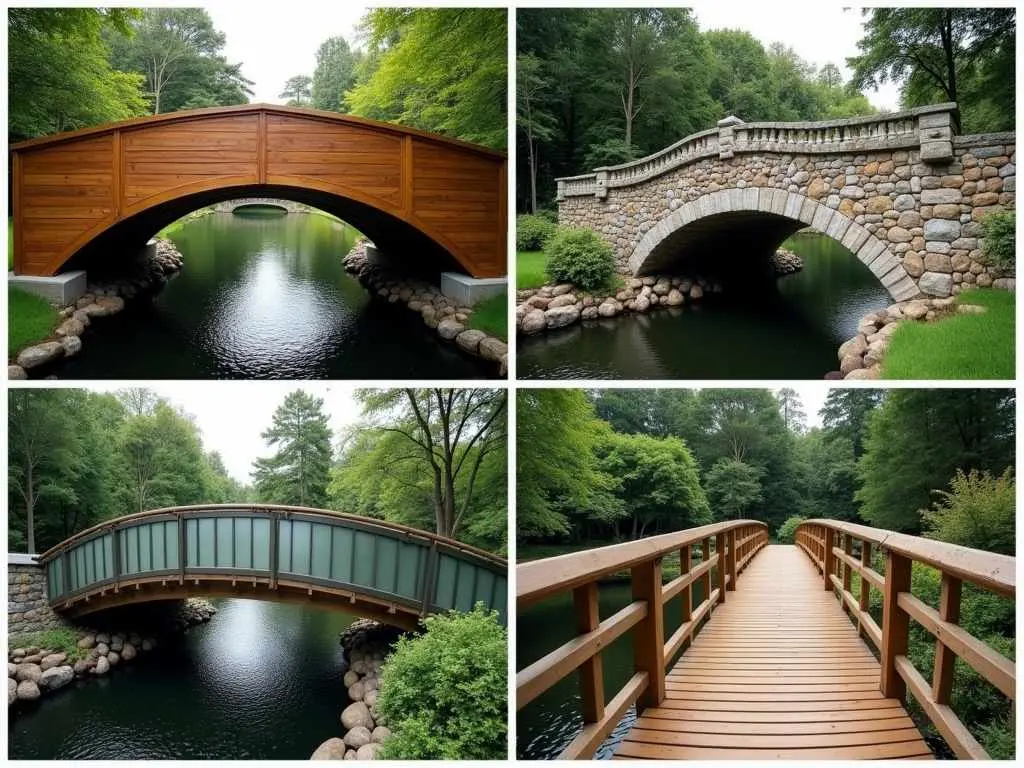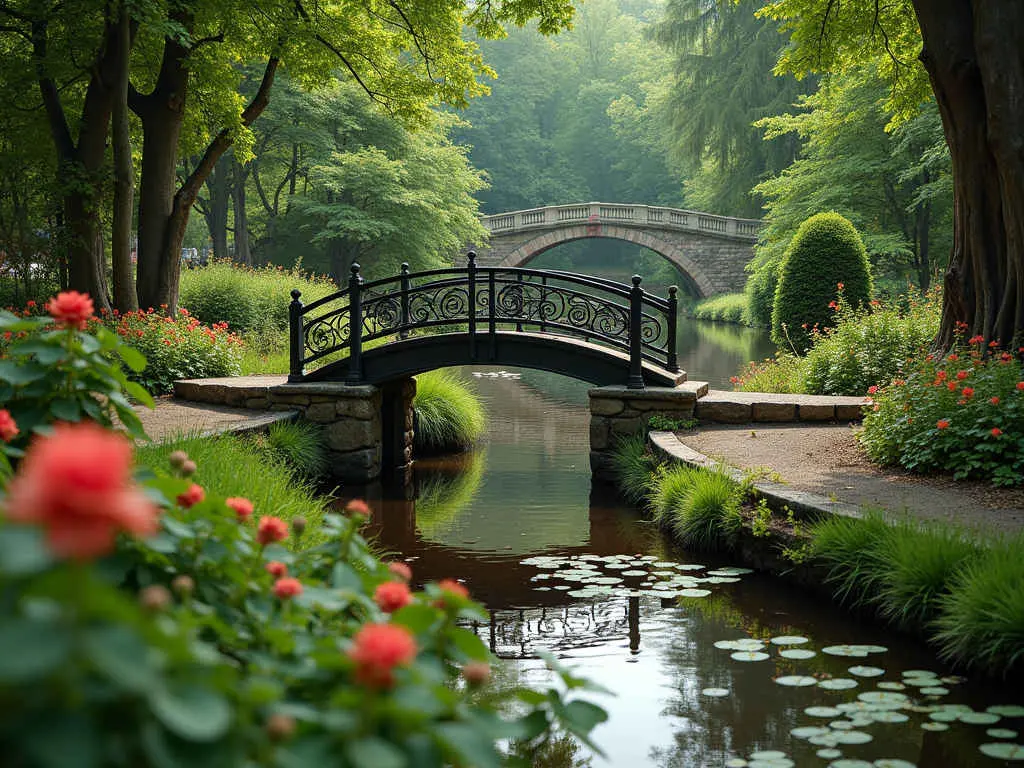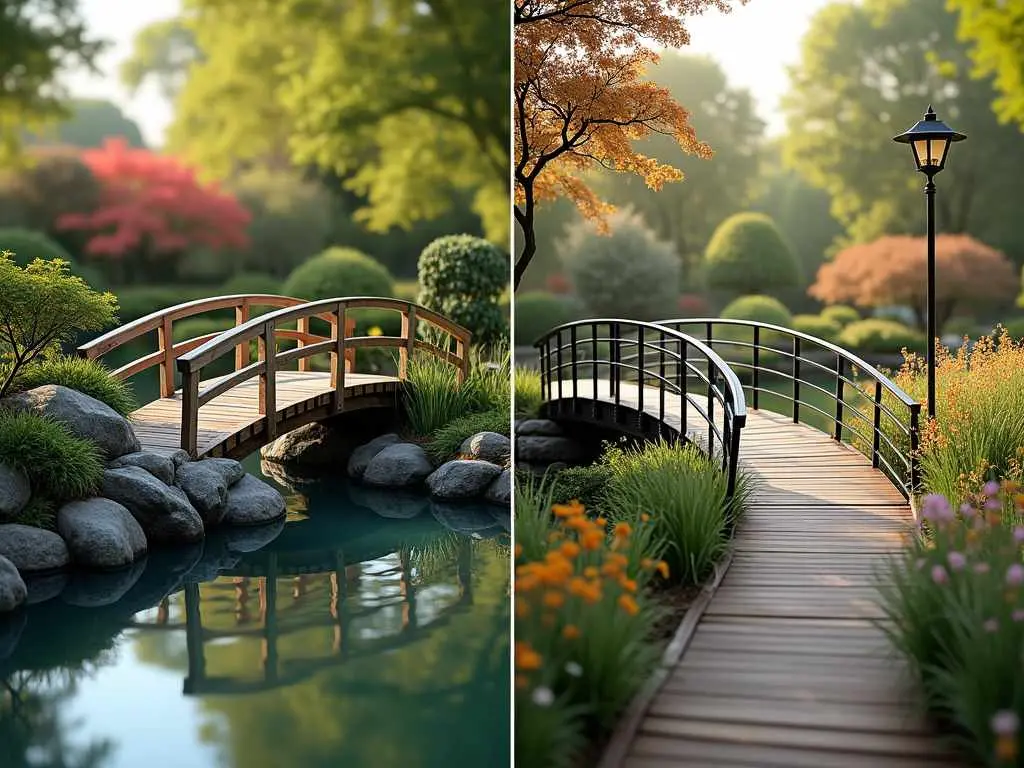As an experienced landscape architect specializing in integrating structural elements with natural environments, I’ve seen firsthand how garden bridges can transform outdoor spaces. At Curvspace, we believe that thoughtful design enhances both aesthetics and functionality. This comprehensive guide will explore the world of garden bridges, offering insights into their design, construction, and impact on landscape architecture.
Jump to:
The Allure of Garden Bridges
Garden bridges serve as more than mere functional structures; they are focal points that add charm, intrigue, and a sense of journey to outdoor spaces. These architectural elements can transform a simple garden into a captivating landscape, bridging not just physical gaps but also creating emotional connections between different areas of your outdoor sanctuary.
Historical Significance
Garden bridges have a rich history dating back centuries, with roots in various cultures around the world. In Japanese garden design, for instance, bridges symbolize the passage from the mundane to the spiritual realm. European formal gardens often incorporated ornate bridges as statements of grandeur and artistic expression.
Modern Applications
Today, garden bridges blend these historical influences with contemporary design principles. They serve multiple purposes:
- Functional crossings over water features or uneven terrain
- Aesthetic focal points in landscape design
- Symbolic elements representing journeys or transitions
- Viewing platforms for appreciating the surrounding garden
Types of Garden Bridges

Garden bridges come in various styles and materials, each offering unique aesthetic and functional benefits. Let’s explore some popular types:
Wooden Bridges
Wooden bridges are perhaps the most versatile and widely used in garden design. They offer a natural, rustic charm that complements most landscape styles.
Advantages:
- Blend seamlessly with natural surroundings
- Can be easily customized and painted
- Generally more affordable than stone or metal options
Considerations:
- Require regular maintenance to prevent rot and decay
- May not be suitable for very large spans without additional support
Stone Bridges
Stone bridges provide a sense of permanence and timelessness to a garden. They’re ideal for creating a classic or formal look.
Advantages:
- Extremely durable and long-lasting
- Require minimal maintenance
- Can support heavy loads
Considerations:
- Often more expensive to construct
- Limited in span length without additional engineering
Metal Bridges
Metal bridges offer a contemporary look and can be designed in various styles, from minimalist to ornate.
Advantages:
- Highly customizable in design
- Can span longer distances with less support
- Durable and weather-resistant
Considerations:
- May require periodic painting or coating to prevent rust
- Can be more expensive than wooden options
Composite Material Bridges
Bridges made from composite materials are gaining popularity due to their durability and low maintenance requirements.
Advantages:
- Resistant to rot, decay, and insect damage
- Low maintenance
- Can mimic the look of wood or other materials
Considerations:
- May have a higher upfront cost
- Limited color options compared to painted wood
Designing Your Garden Bridge

Designing Your Garden Bridge
When designing a garden bridge, consider the following factors:
- Purpose: Is the bridge primarily functional, decorative, or both?
- Style: Should it complement existing garden elements or stand out as a focal point?
- Size: Consider the span needed and the proportions relative to the surrounding landscape.
- Materials: Choose materials that match your garden’s aesthetic and maintenance preferences.
- Safety: Ensure the bridge is sturdy and includes appropriate railings if necessary.
Design Principles
To create a visually appealing and functional garden bridge, keep these design principles in mind:
- Proportion: The bridge should be in scale with its surroundings.
- Integration: Design the bridge to complement existing landscape features.
- Sight Lines: Consider how the bridge will look from different vantage points in the garden.
- Accessibility: Ensure the bridge is easy to use for all intended users.
Functional Aspects of Garden Bridges
While aesthetics are important, the functionality of a garden bridge should not be overlooked. Here are some key functional considerations:
Load-Bearing Capacity
Determine the expected load for your bridge. Will it be used only for foot traffic, or does it need to support heavier loads like maintenance equipment?
Span and Support
The length of the span will influence the type of bridge and materials you can use. Longer spans may require additional support structures.
Weather Resistance
Choose materials and designs that can withstand your local climate conditions, including rain, snow, and temperature fluctuations.
Maintenance Requirements
Consider the long-term maintenance needs of different materials and designs. Some may require more frequent upkeep than others.
Construction and Installation
Building a garden bridge requires careful planning and execution. Here’s an overview of the process:
- Site Preparation: Clear and level the area where the bridge will be installed.
- Foundation Work: Create stable footings or abutments to support the bridge.
- Bridge Assembly: Construct the main structure of the bridge.
- Decking and Railings: Install the walking surface and any necessary safety features.
- Finishing Touches: Apply protective coatings, paint, or decorative elements.
For complex designs or larger bridges, it’s advisable to consult with a professional landscape architect or structural engineer.
Integrating Bridges into Landscape Design

A well-designed garden bridge should enhance the overall landscape. Consider these integration strategies:
Creating Focal Points
Position your bridge where it can serve as a visual anchor for the garden. This could be at the end of a path or as a centerpiece over a water feature.
Framing Views
Use the bridge to frame picturesque views of your garden or the surrounding landscape.
Enhancing Movement
Design paths that lead to and from the bridge, encouraging exploration of the garden.
Complementing Water Features
If your garden includes a pond or stream, a bridge can provide both functional crossing and aesthetic enhancement.
Maintenance and Care
Proper maintenance is crucial for preserving the beauty and functionality of your garden bridge. Here are some general maintenance tips:
- Regular Inspections: Check for signs of wear, damage, or loose components.
- Cleaning: Remove debris, moss, and algae growth regularly.
- Protective Treatments: Apply appropriate sealants or paints to protect against weather damage.
- Structural Repairs: Address any structural issues promptly to prevent further damage.
Environmental Considerations
When designing and building a garden bridge, it’s important to consider its environmental impact:
Sustainable Materials
Choose materials that are sustainably sourced or recycled. For wooden bridges, look for FSC-certified timber.
Minimal Disruption
Design and construct the bridge in a way that minimizes disruption to the existing ecosystem, especially if spanning natural water features.
Wildlife-Friendly Design
Incorporate features that benefit local wildlife, such as built-in nesting boxes or pollinator-friendly plantings along the approaches.
Water Management
Ensure that the bridge design doesn’t negatively impact water flow or quality in streams or ponds.
Innovative Bridge Designs
As landscape architecture evolves, so do bridge designs. Here are some innovative approaches to garden bridges:
Living Bridges
Inspired by the root bridges of Meghalaya, India, these bridges incorporate living plants into their structure, growing stronger over time.
Illuminated Bridges
Integrating LED lighting into bridge designs can create stunning nighttime displays and extend the usability of the garden into evening hours.
Interactive Bridges
Some modern designs incorporate interactive elements like sound or movement sensors, creating a dynamic experience for garden visitors.
Modular Designs
Prefabricated, modular bridge designs offer flexibility and ease of installation, particularly useful for temporary or changeable garden layouts.
Case Studies
Let’s examine some real-world examples of exceptional garden bridge designs:
Case Study 1: The Monet Bridge, Giverny, France
Claude Monet’s iconic Japanese-inspired bridge showcases how a simple arched design can become a timeless garden centerpiece.
Key Takeaways:
- Demonstrates the power of color in bridge design
- Illustrates effective integration with surrounding plantings
- Shows how a bridge can inspire art and become a cultural icon
Case Study 2: Henderson Waves Bridge, Singapore
While not a traditional garden bridge, this urban park bridge exemplifies innovative design that harmonizes with nature.
Key Takeaways:
- Showcases the use of curved forms in bridge design
- Demonstrates how a bridge can serve as both a functional walkway and a relaxation space
- Illustrates the integration of seating areas within the bridge structure
Case Study 3: Tōgetsu-kyō Bridge, Arashiyama, Japan
This historic bridge in Kyoto demonstrates the enduring appeal of traditional design principles.
Key Takeaways:
- Highlights the importance of context in bridge design
- Shows how a bridge can frame and enhance natural scenery
- Demonstrates the use of natural materials in harmony with the environment
People Also Ask
Q: How much does it cost to build a garden bridge?
Use light colors, incorporate mirrors, and opt for slim-profile furniture to create the illusion of more space. Adequate lighting and vertical storage solutions can also help maximize the area.
Q: Do I need a permit to build a garden bridge?
Consider using modular shelving units, installing a pegboard for customizable storage, or adding a fold-down desk. DIY projects like creating a gallery wall with adjustable shelves can also be cost-effective options.
Q: How wide should a garden bridge be?
A: The width of a garden bridge depends on its intended use. For single-file foot traffic, a minimum width of 3 feet (0.9 m) is recommended. For comfortable two-way traffic or wheelchair accessibility, aim for at least 4 to 5 feet (1.2 to 1.5 m) wide. Decorative bridges can be narrower if not intended for regular crossing.
Conclusion
Garden bridges offer a unique blend of functionality and aesthetics, capable of transforming outdoor spaces into enchanting landscapes. By carefully considering design principles, materials, and integration with the surrounding environment, you can create a bridge that not only serves its practical purpose but also becomes a captivating focal point of your garden. Whether you opt for a classic wooden arch or an innovative living structure, a well-designed garden bridge will enhance your outdoor experience for years to come.
References
- American Society of Landscape Architects. (2023). “Sustainable Bridge Design in Landscape Architecture.” ASLA Professional Practice Networks.
- National Park Service. (2022). “Guidelines for the Treatment of Cultural Landscapes.” U.S. Department of the Interior.
- Royal Horticultural Society. (2024). “Garden Structures: Bridges and Walkways.” RHS Gardening Advice.
Disclosure
Our content is reader-supported. This means if you click on some of our links, then we may earn a commission. Commissions do not affect our editor’s opinions or evaluations. Learn more about our editorial process.

About the Editorial Staff
The Curvspace editorial team comprises a diverse group of experts on intermediate and threshold spaces in homes and workplaces. Architects and interior designers, civil engineers and artists, environmental and behavioral psychologists, sociologists and anthropologists. All collaborate to create helpful content, that explores the full potential of these often-overlooked areas to enhance our daily lives.


